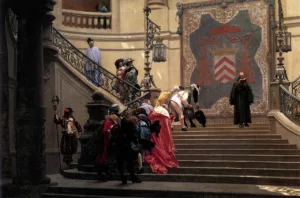Post by Andrea Kirsh

Václav Zykmund, Czech (1914–1985), Self-portrait [Vlastní podobizna], 1936
gelatin silver print, 18 x 13 cm (7 1/16 x 5 1/8), Moravská galerie, Brno
The most delightful (as well as educational) exhibition experiences are those where I’m exposed to a first-rate body of work that I didn’t know, which was decidedly the case at the National Gallery’s “Foto; Modernity in Central Europe, 1918-1945″ (through Sept. 3; East Coast viewers will have a second chance to see it in NYC at the Guggenheim, Oct. 5, 2007-Jan. 2, 2008, after which it will travel to Milwaukee and Edinburgh). The exhibition set out to explore a center of experimentation and production that’s been left out of standard photographic histories, with their focus on Russia, Germany, France and the U.S.

Ladislav Berka, Czech (1907-1993), New Construction [Nová stavba], from the series Prague Overprinted [Praha v surimpresi], 1929-1930, gelatin silver print, 12.2 x 14.6 cm (4 13/16 x 5 3/4), Museum Folkwang, Essen
True, everyone knew that László Moholy_Nagy had a central place in photographic education; he taught at the Bauhaus, wrote photography’s first theoretical treatise, then taught in Chicago; and André Kertész and Martin Munkacsi were early photojournalists. Still, we never thought to ask who they left behind in Budapest. The exhibition covers photography in Germany, Czechoslovakia, Austria, Hungary and Poland and other than the Germans, most of the photographers were unknown to me, and probably to artblog readers; it includes over a hundred artists and only 21e were even familiar names. This isn’t really a surprise, as many of these photographs had never been exhibited in the U.S.

Paul Citroen (b. Germany, 1896-1983), Metropolis, 1923, photomontage, 76.1 x 58.4 cm (29 15/16 x 23), Prentenkabinet, University Library, Leiden, © 2007 Paul Citroen Artists Rights Society (ARS), New York/Beeldrecht, Amsterdam
The approach to photography was varied: straight reportage (some with extreme camera angles), various darkroom experimentation including overprinting, and a large number of photo-montages, some of which were themselves photographed. The artists were as conscious of questions of reproduction and appropriated imagery as any post-modernist. Paul Citroen’s “Metropolis” (1923) was one of the high points of the show and one of those few images I recognized. But I hardly knew it. Citroen created a giant image (30″ x 23″) of a modern city crowded with vertical buildings, elevated railways, and bridges, images of which he’d clipped out of newspapers and magazines. He made copies of the large collage to be sold as an edition, and it was widely reproduced in magazines and books, which was how I had known it. Coming upon its full scale made me gasp – a reaction that would have pleased Citroen, who wanted his collages to have the stature of paintings.

František Vobecký, Czech (1902-1991), Untitled (Dancer) [Bez názvu (Tanečnice)], 1930s, gelatin silver print, 39.1 x 29.6 cm (15 3/8 x 11 5/8), The J. Paul Getty Museum, Los Angeles
The exhibition emphasizes the interaction of photography with modernity, which in central Europe was characterized by urbanization, industrialization, new roles and visibility for women and the working class, as well as what the curator calls an “emancipatory nationalism” (a reaction to being freed from the Hapsburgs and Hohenzollern). The inter-war period covered by the exhibition begins and ends with imported art movements: Dada, which had come to Berlin from Zurich, and Surrealism, which began in Paris but had a substantial development in Prague.

Hannah Höch (1889-1978), Heads of State, 1918-1920
photomontage (printed matter), 16.2 x 23.3 cm (6 3/8 x 9 3/16), Institut für Auslandsbeziehungen e.V., Stuttgart, © 2007 Hannah Höch Artist Rights Society (ARS), New York/Bild-Kunst, Bonn
Some favorites are: Hannah Höch’s “Heads of State” (a newspaper photo of the president of Weimar Germany and his minister of defense in bathing suits, pasted on a drawing of a mermaid, with crudely cut-out waves in the foreground), Jaromír Funke’s series Abstract Photo (resembling photograms, but made with a camera), Karol Hiller’s “Composition” (a cliché verre, done by painting on glass then exposing photographic paper to the resulting painting) and Frantisek Vobecký’s “Untitled (Dancer)” (photograph of a composition made out of unidentifiable detritus); but I could have chosen another four or yet another.

Karol Hiller (1891-1939), Composition, 1930s, gelatin silver print (heliografika), National Museum in Warsaw
The exhibition is full of fascinating images that show a generation of photographers playing with the possibilities of photography even as they are responding to enormous social and political changes.

Jaromír Funke (1896-1945), Abstract Photo, 1928-1929,gelatin silver print, 29.9 x 23.5 cm (11 3/4 x 9 1/4), Moravská galerie, Brno
I intend to see the exhibition again, either in D.C. or New York. It opens up a world that should be known by anyone interested in photography or European art between the wars. There’s a beautifully-designed and produced catalogue with extensive writing by the curator, Matthew S. Witkovsky (who situates the photography within contemporary artistic, intellectual and social currents in very clear language), an introduction by Peter Demetz, an extensive bibliography and very useful biographies of each of the artists. The exhibition and catalogue are major contributions to the field.
–Andrea Kirsh is an art historian based in Philadelphia. You can read her recent Philadelphia Introductions articles at inLiquid.









